Everybody knows there’s nothing more frustrating than sitting down to watch television only to find your signal pixelating or even not working altogether. If you were suffering from poor TV reception in general, it can be caused by several different issues – having poor or even too much TV signal, interference, or bad equipment. There are a few tips that we gathered together that can help you improve your TV reception and avoid regularly losing signal and getting that awful static picture on your screen.

Contents
Check and improve your wiring
In most cases, poor reception might simply be the result of poor or disconnected wiring. The first step in asserting the cause of a problem of this kind should be checking your cables. Make sure that all of the cables are connected securely and if they are, try disconnecting and reconnecting the cables from your TV to your satellite dish and power sockets. A hard reset of the equipment might even fix your problem. Additionally, check the quality of your coax cable. Coax for TV aerials should be at least double screened and have a solid center conductor. Otherwise, you might be losing an excessive amount of signal down the cable which could cause the TV signal to become weak.
Install your aerial outside
Installing your TV aerial outside is probably the best thing you can do to improve your TV signal if it has not already been done like that. This way your signal will benefit from the fact that the signal does not need to pass through your roof tiles, and can also avoid any nearby obstructions like neighboring buildings or trees. However, according to experts in this field from Freesat TV installation and repairs, you should always consult professionals since the best type and position of the aerial might vary depending on many factors. Still, everyone will agree on the fact that you will almost always have a good signal If you can see your transmitter when installing your TV aerial.

Install the aerial higher
TV aerials were nearly always installed on chimneys and there is a particularly good reason for it – they provided a fixing point that is typically the highest point of your house. Meaning that if you live in an area with poor signal, you could benefit from installing your aerial onto a higher point by clearing any nearby obstructions this way. your fixings must also be big enough to support your aerial, for safety reasons, ideally 1/6th of the total height, otherwise, it might get blown away by the wind. In case it isn’t possible to install an aerial on the outside of your home and you have to use an indoor aerial, the best idea is to move up to a loft aerial.
Install a masthead amplifier
If none of the suggestions above mentioned didn’t work out well enough, the next best thing to do is installing a masthead amplifier. If you choose this course of action, the best option is to install it as close to the aerial as possible, as this will boost the signal throughout your system. Masthead amplifiers are tools used to overcome cable and signal losses associated with splitting the signal to multiple TVs. Outdoors would be the perfect place to install the masthead and power supplied from behind the TV through the aerial cable. If you generally get a weak signal often, you will surely benefit from using an amplifier.
Remove splitters and install distribution amplifiers
Using splitters to run multiple TVs from one aerial increases the signal loss, and they increase more with every TV added to the system. This isn’t usually an issue for up to four TVs in a household if a strong signal is expected. However, in situations of more than four TVs in the system or the weaker signal, using a splitter can cause losing some. This issue can be resolved by using a distribution amplifier with multiple outputs to different TVs. This reduces signal loss and improves the signal strength of all TVs. The amplifier will also have around 10dB signal gain as well to help overcome cable signal losses. Even though it doesn’t seem logical, the more TVs you add, the greater the signal received by each will be.
Finally, if not a single one of these tips aren’t working for you, you might have to try and change your supplier, but before you sign another contract, make sure to consult a specialist and ask for a recommendation. Since television signals can be affected by almost anything, and while you might be suspecting a more serious problem, sometimes the most obvious solutions are the most effective. However, before doing anything on your own, it is strongly advised to contact professional support.



